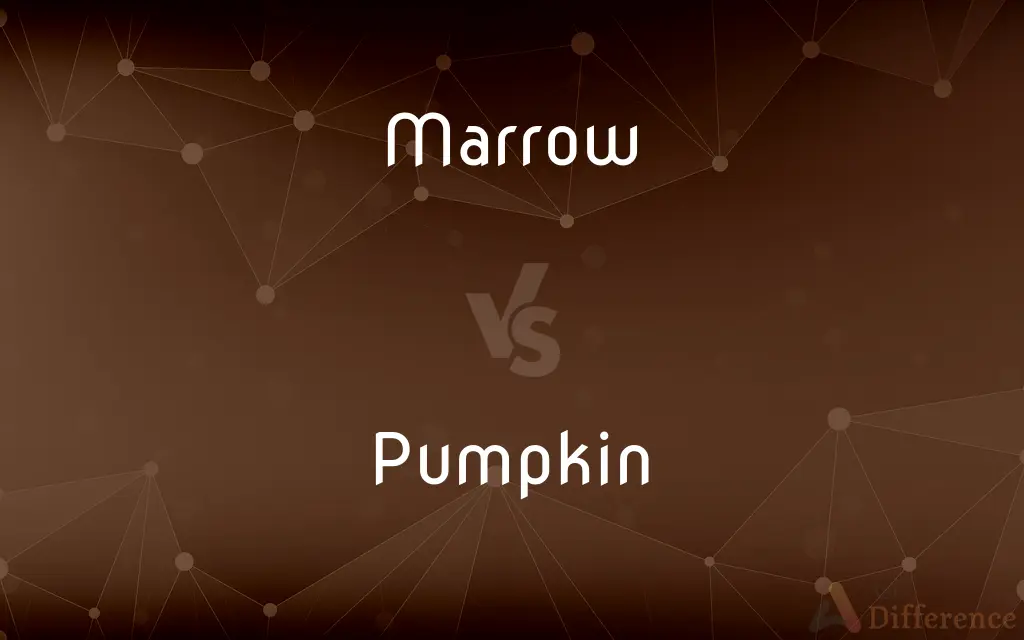Marrow vs. Pumpkin — What's the Difference?
By Urooj Arif & Fiza Rafique — Updated on March 8, 2024
Marrow and pumpkin are both members of the Cucurbitaceae family, with marrow focusing on elongated, mild-tasting vegetables, while pumpkin is known for its round shape, vibrant color, and association with fall festivities.

Difference Between Marrow and Pumpkin
Table of Contents
ADVERTISEMENT
Key Differences
Marrow is a term that can refer to a variety of summer squash that is typically elongated, green-skinned, and has a soft texture with a mild flavor when cooked. It's often used in dishes that require a subtle vegetable taste and can be stuffed, baked, or incorporated into soups and stews. Pumpkin, on the other hand, refers to a round, often orange squash that is part of the winter squash family. Pumpkins are celebrated for their strong association with fall traditions such as Halloween and Thanksgiving, where they are carved into jack-o'-lanterns or used in recipes like pumpkin pie.
Marrows are harvested when immature to ensure their skin remains tender and their seeds undeveloped, making them easy to cook and eat. Unlike marrow, pumpkin has a distinct, sweet flavor that makes it suitable for both savory dishes and desserts. Its flesh is firmer, and the skin is thicker, requiring longer cooking times.
While both marrow and pumpkin are versatile in the kitchen, their uses reflect their textural and flavor differences. Marrow's mild taste makes it a versatile backdrop for a variety of ingredients, allowing other flavors to shine through. Pumpkin's sweetness and firmer texture lend it well to being the star of a dish, whether it's roasted as a side, blended into soups, or baked into pies.
The cultivation of marrow and pumpkin also reflects their differing roles in culinary traditions. Marrows are grown primarily for immediate consumption during the summer months, offering a tender vegetable option for a variety of dishes. Pumpkins, with their hardier nature, are harvested in the fall and can be stored for use throughout the winter months, making them a staple in seasonal dishes and celebrations.
While both marrow and pumpkin are valuable members of the squash family, their distinct characteristics and culinary uses set them apart. Marrow, with its tender flesh and mild flavor, is a versatile vegetable for summer dishes, whereas pumpkin is celebrated for its sweet flavor and cultural significance during the fall season.
ADVERTISEMENT
Comparison Chart
Shape
Elongated
Round
Color
Typically green
Often orange, but can vary
Texture
Soft and tender
Firmer and more fibrous
Flavor
Mild
Sweet and nutty
Culinary Uses
Stuffed, baked, soups, stews
Pies, roasted, soups, desserts
Harvest Time
Summer
Fall
Cultural Significance
Less culturally specific
Strongly associated with fall festivities
Storage
Consumed fresh, not typically stored
Can be stored for months
Compare with Definitions
Marrow
Elongated, green-skinned vegetable.
He grew an impressive marrow in his vegetable garden.
Pumpkin
Associated with fall celebrations.
Pumpkins are a staple decoration in fall festivities.
Marrow
Often used in savory dishes.
Marrow soup is a comforting meal for a cool summer evening.
Pumpkin
Used in both savory and sweet dishes.
Roasted pumpkin seeds make a nutritious snack.
Marrow
A type of summer squash with a mild taste.
She prepared a delicious stuffed marrow for dinner.
Pumpkin
A round, often orange winter squash.
The pumpkin was carved into a jack-o'-lantern for Halloween.
Marrow
Tender flesh and skin when young.
The tender marrow was easily scooped out for the recipe.
Pumpkin
Sweet and nutty flavor profile.
Pumpkin pie is a traditional Thanksgiving dessert.
Marrow
Versatile in cooking methods.
Baked marrow is a simple yet satisfying side dish.
Pumpkin
Can be stored and used throughout winter.
Stored pumpkins provide a versatile ingredient for winter recipes.
Marrow
Bone marrow.
Pumpkin
A pumpkin is a cultivar of winter squash that is round with smooth, slightly ribbed skin, and is most often deep yellow to orange in coloration. The thick shell contains the seeds and pulp.
Marrow
The spinal cord.
Pumpkin
A round, often large squash with coarse, strongly flavored yellow to orange flesh, numerous seeds, and a moderately hard, usually orange rind.
Marrow
The marrow squash.
Pumpkin
Any of several plants producing these fruits, especially varieties of the species Cucurbita pepo, and also varieties of C. maxima and C. moschata.
Marrow
The inmost, choicest, or essential part; the pith.
Pumpkin
A moderate to strong orange.
Marrow
Strength or vigor; vitality.
Pumpkin
A domesticated plant, in species Cucurbita pepo, similar in growth pattern, foliage, flower, and fruit to the squash or melon.
Marrow
(countable) A kind of vegetable like a large courgette/zucchini or squash.
Pumpkin
The round yellow or orange fruit of this plant.
Marrow
The pith of certain plants.
Pumpkin
(uncountable) The color of the fruit of the pumpkin plant.
Marrow
The essence; the best part.
Pumpkin
(Australia) Any of a number of cultivars from the genus Cucurbita; known in the US as winter squash.
Marrow
The inner meaning or purpose.
Pumpkin
(US) A term of endearment for someone small and cute.
Marrow
Bone marrow biopsy.
This patient will have a marrow today.
Pumpkin
A well-known trailing plant (Cucurbita pepo) and its fruit, - used for cooking and for feeding stock; a pompion.
Marrow
(obsolete) Semen.
Pumpkin
A coarse vine widely cultivated for its non-keeping large pulpy round orange fruit with firm orange skin and numerous seeds; subspecies of Cucurbita pepo include the summer squashes and a few autumn squashes
Marrow
A friend, pal, buddy, mate.
Cheers marrow!
Pumpkin
Usually large pulpy deep-yellow round fruit of the squash family maturing in late summer or early autumn
Marrow
One of a pair; a match; a companion; an intimate associate.
Marrow
The tissue which fills the cavities of most bones; the medulla. In the larger cavities it is commonly very fatty, but in the smaller cavities it is much less fatty, and red or reddish in color.
Marrow
The essence; the best part.
It takes from our achievements . . .The pith and marrow of our attribute.
Marrow
One of a pair; a match; a companion; an intimate associate.
Chopping and changing I can not commend,With thief or his marrow, for fear of ill end.
Marrow
To fill with, or as with, marrow or fat; to glut.
Marrow
The fatty network of connective tissue that fills the cavities of bones
Marrow
Any of various squash plants grown for their elongated fruit with smooth dark green skin and whitish flesh
Marrow
Very tender and very nutritious tissue from marrowbones
Marrow
Large elongated squash with creamy to deep green skins
Marrow
The choicest or most essential or most vital part of some idea or experience;
The gist of the prosecutor's argument
The heart and soul of the Republican Party
The nub of the story
Common Curiosities
Can you substitute marrow for pumpkin in recipes?
While possible, the substitution would affect the dish's flavor and texture due to their differences, with marrow being milder and softer.
What is the main difference between marrow and pumpkin?
The main difference lies in their shape, flavor, and culinary uses, with marrow being mild and versatile, and pumpkin being sweet and associated with fall festivities.
How long can you store pumpkins compared to marrows?
Pumpkins can be stored for several months in a cool, dry place, while marrows are best consumed fresh and not typically stored long-term.
Why is pumpkin more associated with fall than marrow?
Pumpkin's harvest time, firm texture for carving, and sweet flavor for traditional fall dishes contribute to its strong association with fall festivities.
Why is pumpkin popular in desserts?
Pumpkin's natural sweetness and smooth texture when cooked make it a popular choice for desserts like pies and cakes.
What cultural significance does pumpkin hold?
Pumpkin is deeply ingrained in fall traditions, especially in North America, symbolizing harvest time and celebrated in Halloween and Thanksgiving traditions.
Is the skin of marrow edible?
Yes, when young and tender, the skin of marrow is edible and often cooked along with the flesh.
Are marrow and pumpkin nutritionally similar?
Both are nutritious, offering vitamins and minerals, but their nutritional profiles differ slightly due to their distinct flesh and intended culinary uses.
Can both marrow and pumpkin be grown in a home garden?
Yes, both can be grown in a home garden, with marrow being a summer crop and pumpkin a fall crop, reflecting their different growing and harvest times.
How do the textures of marrow and pumpkin affect their culinary uses?
Marrow's tender texture suits dishes where it can be easily incorporated or stuffed, while pumpkin's firmer texture makes it ideal for baking, roasting, or pureeing.
Share Your Discovery

Previous Comparison
Musk vs. Oud
Next Comparison
Acetaldehyde vs. FormaldehydeAuthor Spotlight
Written by
Urooj ArifUrooj is a skilled content writer at Ask Difference, known for her exceptional ability to simplify complex topics into engaging and informative content. With a passion for research and a flair for clear, concise writing, she consistently delivers articles that resonate with our diverse audience.
Co-written by
Fiza RafiqueFiza Rafique is a skilled content writer at AskDifference.com, where she meticulously refines and enhances written pieces. Drawing from her vast editorial expertise, Fiza ensures clarity, accuracy, and precision in every article. Passionate about language, she continually seeks to elevate the quality of content for readers worldwide.
















































